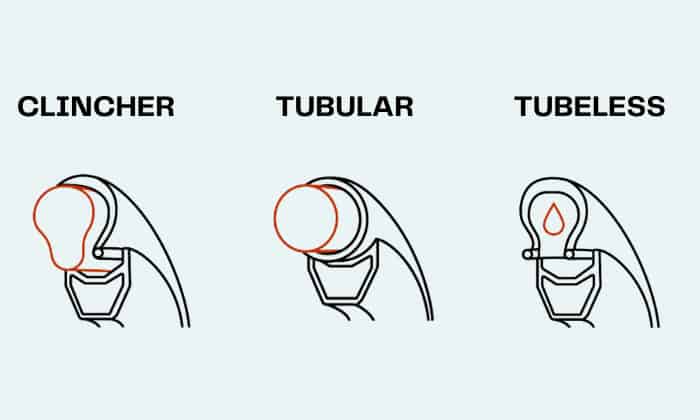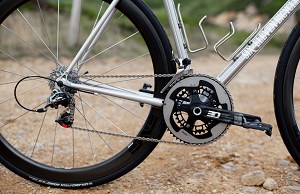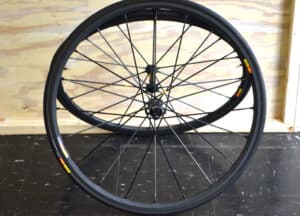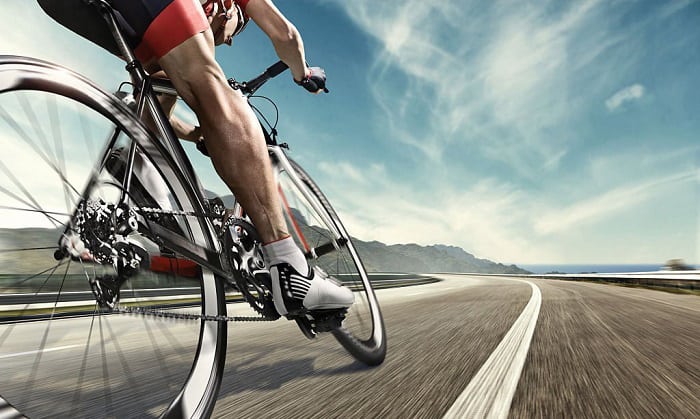Setting up your bicycle may not be as easy as you expect, particularly when choosing the tire that will fit your needs. Among clincher vs tubular vs tubeless tires, perhaps you found yourself thinking about what tire option you should pick out.
Worry no more, as this comprehensive article will answer everything you need to know about each tire type – allowing you to make an informed selection right now!
| Clincher | Tubular | Tubeless |
| Default tire type among bike models | Preferred option for competitive races | A relatively new option, popular in road cycling and racing |
| Constructed with beads that consist of wires, “clinched” onto the wheel rim. | Tube sewn into the tire. Made of latex | Has similar clincher-type features without the inner tube to inflate air |
Table of Contents
Comparison in Detail
There are three main types of tires currently available on the market. Here are their classifications, features, and costs to help you identify which will work best for your next upgrade.
What is it?
Now, if you are dwelling on clincher vs. tubular vs. tubeless tires, a glimpse at these bike tires might give you an idea of what to expect from each type.
1. Clincher Tires
So, what are clincher bike tires? A clincher tire comprises a wheel connected to a bead through a clincher rim.
Commonly regarded as the standard tire in most bike models, this tire is relatively easy to repair or replace with a new tube.
2. Tubular Tires
Tubular tires resemble clinchers with reduced weight, often regarded as the touchstone for competitive hardcore and professional bike riders.
With their lighter features, riding with tubular tires will surely be bliss. However, flat repair for a road bike with tubular wheels is a bit trickier than a clincher tire bicycle.
3. Tubeless Tires
A considerably new setup that is gaining traction among cyclists in road and bike racing, its airtight arrangement allows lower air pressure, providing better rolling resistance on smooth and rough surfaces.
Differences
Let us understand the differences between tubeless vs clincher vs tubular tires, so you can determine the optimal choice among them.
1. Definition
Each type’s name denotes its practical features and uses.
The meaning behind the clincher tire definition alludes to its “clinch” placement onto the wheel rim with a firm rubber bead. Meanwhile, tubeless refers to tires with a similar clinching attachment but no-inner tube mechanism.
Tubulars, meanwhile, describe a tube sewn directly to a tire. Such a feature earned its tags such as sew-up in the US, tub in Britain, and single in Australia.
2. Materials
Several materials make up bike tires, with each type including similar and distinct pieces.
A clincher wheelset has a tire casing and thread, usually made from rubber encased around the bead. With its built, clinchers utilize two types of bead: folding and wire.
The difference between a folded clincher vs wire bead lies in the material used. Folding clinchers have synthetic fibers, like Kevlar, that give them lighter weight, while a wire bead includes steel wire, making it rigid.
For tubeless tires, a butyl rubber is used for the inner line casing or a liquid tire sealant is present to make them airtight.
On the other hand, tubular wheels are made from latex materials, allowing them to resist cuts better and ensure you don’t get stranded in the middle of the road.
3. Construction
With a similar-looking build to an automotive tire, clinchers are like a casing incorporated into a bead. It gives firm and stable functionality due to its function, keeping the tire seated on the rim as air pressure increases.
Although clincher wheels vs tubular similarities include the utilization of an inner tube for air inflation, the main difference between tubular vs clincher wheels is their build.
Tubular tires are circular and include an inner tube integrated into the tire itself. Yet, it lacks the thick sidewall that clincher tire bicycle models have.
Meanwhile, tubeless models have no tubes at all, though they have a sealant that is added through valves and must be renewed from time to time.
4. Installation
The installation methods for tubeless vs. tubular vs. clincher wheels require several tools and materials like a pump, glue or rim tape, bicycle tube, and tire lever.
5. Clincher tires
Before starting, ensure the proper installation of rim tape on your clincher wheels. When positioning clincher tires tubeless models, add an extra layer of tape to increase the depth of the rim bed.
Then, shape the tire by smoothing the creases and pinch the carcass edges with your fingers. Install the first half of the tire over the rim with a tire lever, and leave an opening to position the conventional tube onto the wheel.
Place the valve into the hole and feed the tube underneath the tire and to the rim. Work the other half of the tire over the rim and seal it.
6. Tubeless tires
When installing a tubeless tire, first, confirm if your wheels have tubeless-ready or compatible rim and tire. If you don’t have tubeless-ready wheels, you must install the rim tape first.
Look for a hole and pull the valve through it. Put the O-ring, a packing joint between the rim and the nut, at the base of the tubeless valve preceded by the tire lock nut.
Firmly tighten the valve core onto the rim to avoid air tire leak, then unscrew the valve center using a valve core removal tool.
Install the tire while pointing it in the correct direction with the tread facing forward. Now, pump vigorously and repeatedly until reaching adequate pressure.
Once the tire is evenly seated around the rim, release the inflated air. On the valve, pour 2 to 3 ounces of sealant and reinsert the valve core afterward.
7. Tubular tires
When installing a tubular tire, stretch it first to ease the installation process, inflating it into full pressure a day before the procedure.
To start, glue the rim surface with a flux brush, applying a thin coat on its edges. Repeat this step on the tire’s base tape, painting the glue on its cloth-textured surface.
Deflate the tire. When ready, attach the tire to the wheel, stretching it over until placed correctly to the rim.
See if the valve stem is pointing straight before inflating, and make sure the base tape is consistent around the entire rim.
Pros and cons
Based on your bike model, there are advantages and disadvantages related to your tire choice.
Between tubeless vs tubular designs, the better option when riding mtb is a tubeless setup. Tubular wheels also provide excellent acceleration and climbing efficiency; however, they are more troublesome to fix when there are flats.
As for clincher vs tubeless, riding on a road bike with tubeless tires works to the advantage of cyclists who want the benefits of low-pressure tires and high rolling performance on uneven ground.
Punctures on tubeless models could seal on their own or be repaired easily with a tire plug. Nevertheless, burping or air and sealant can escape from the tire, raising the risks of punctures being a nuisance.
On the other hand, a clincher setup is a better alternative for cyclists aiming for longer bike rides, since it’s easier to repair or replace on the road. However, it’s heavier and less transportable than tubular types.
For a better comparison, you can also check out this video: GNC tubeless vs clincher vs tubular.
Cost
Tubulars cost more than clinchers, and tubeless tires are priced the highest among all three variations.
Frequently Asked Questions
Is clincher or tubular better?
Based on your riding needs, what’s better between clinchers and tubular will vary.
When it comes to durability, a tubular is better than clinchers. So, having tubular tyres 700c will give you better mileage, allowing you to ride safely under various pressure levels whenever facing flats.
Although tubular tires have features that work to the advantage of pro cyclists, most riders would still recommend clinchers. Due to their universality, ease of use, and economical price, clinchers are preferred by many.
Are clincher and tubeless the same?
Tubeless tires are clinchers without inner tubing. Although both tire types look the same, tubeless designs work with a different mechanism, unlike the standard clincher tire that most people know.
Conclusion
Picking a tire among clincher vs tubular vs tubeless tires requires a thorough understanding of each.
There are advantages and disadvantages associated with each one, whether you opt to go for the almost-anywhere availability of clinchers, the better rolling resistance of tubeless models, or the lighter weight of a tubular.
As we discussed all types here, we hope you were able to choose the bike tire that will work best for your next riding escapade. You can always do further research on products such as GCN tubeless vs clincher for the best choice.
Thank you for reading!

“I ride my bike to work for years, but is that enough? Our carelessness towards our surroundings has taken a toll on the environment. And now, everyone is responsible for changes; even the most minor contribution is counted. With this hope and spirit, I started with my partner to establish Biketoworkday to help more individuals commute to their work sites on their bikes.”





